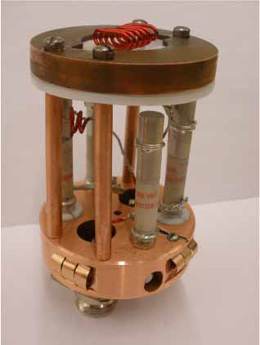Scientists from the University of California Berkeley and The City College of New York have achieved a significant progress towards the realization of quantum computing by finding a method to produce rewritable computer chips utilizing a light beam.
 The probe head used to send radio-frequency pulses onto the coil used for pulsed spin manipulation of a gallium arsenide (semiconductor) sample. (credit: Yunpu Li)
The probe head used to send radio-frequency pulses onto the coil used for pulsed spin manipulation of a gallium arsenide (semiconductor) sample. (credit: Yunpu Li)
The researchers encoded information by controlling the spin of the nucleus of an atom using the light beam. The study findings have been published in Nature Communications. Existing chips can be utilized one way after their printing, informed co-author, Dr. Jeffrey Reime. The researchers found solutions for this drawback in the upcoming sciences of quantum computing and spintronics. They devised a new approach, wherein a laser light is used to pattern the spin alignment inside the atoms. This way, the pattern can be written again on the fly. Such a technique may help create rewritable spintronic circuits in the future.
Classical computers depend on the translation of electrical charges into binary codes of zeros and ones. Conversely, a ‘spintronics’ computer uses the electron spin’s quantum property that allows the electron to store any value between zero and one, which in turn increases processing power by enabling multiple computations to take place concurrently.
The rapid switching back and forth of electron spins makes electrons as highly unstable vehicles to carry information. To overcome this issue, the researchers illuminated a gallium arsenide sample with a laser light pattern to create enduring nuclear spin ‘magnets’ that are capable of pulling, pushing, or stabilizing the electron spins. The illuminated pattern arranged all the atomic nuclei’s spins as well as their electrons instantly, resulting in the formation of a spintronic circuit.
Professor Carlos Meriles, one of the researchers, explained that this results in a chip that is erasable and rewritable on the fly with the help of a light beam. The circuit’s layout can be changed instantly by altering the light pattern, which in turn enables a circuit morph that is adaptable to various needs.